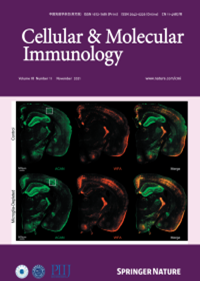Glut3 promotes cellular O-GlcNAcylation as a distinctive tumor-supportive feature in Treg cells
IF 19.8
1区 医学
Q1 IMMUNOLOGY
引用次数: 0
Abstract
Regulatory T cells (Tregs) establish dominant immune tolerance but obstruct tumor immune surveillance, warranting context-specific mechanistic insights into the functions of tumor-infiltrating Tregs (TIL-Tregs). We show that enhanced posttranslational O-linked N-acetylglucosamine modification (O-GlcNAcylation) of cellular factors is a molecular feature that promotes a tumor-specific gene expression signature and distinguishes TIL-Tregs from their systemic counterparts. We found that altered glucose utilization through the glucose transporter Glut3 is a major facilitator of this process. Treg-specific deletion of Glut3 abrogates tumor immune tolerance, while steady-state immune homeostasis remains largely unaffected in mice. Furthermore, by employing mouse tumor models and human clinical data, we identified the NF-κB subunit c-Rel as one such factor that, through Glut3-dependent O-GlcNAcylation, functionally orchestrates gene expression in Tregs at tumor sites. Together, these results not only identify immunometabolic alterations and molecular events contributing to fundamental aspects of Treg biology, specifically at tumor sites but also reveal tumor-specific cellular properties that can aid in the development of Treg-targeted cancer immunotherapies.

Glut3 促进细胞 O-GlcNAcylation 是 Treg 细胞支持肿瘤的一个独特特征。
调节性 T 细胞(Tregs)可建立显性免疫耐受,但会阻碍肿瘤免疫监视,因此有必要从特异性机理角度深入了解肿瘤浸润性 Tregs(TIL-Tregs)的功能。我们的研究表明,细胞因子翻译后O-连接的N-乙酰葡糖胺修饰(O-GlcNAcylation)的增强是促进肿瘤特异性基因表达特征的分子特征,也是区分TIL-Tregs与全身性TIL-Tregs的分子特征。我们发现,通过葡萄糖转运体 Glut3 改变葡萄糖利用是这一过程的主要促进因素。肿瘤浸润特异性地缺失 Glut3 会削弱肿瘤免疫耐受,而小鼠体内的稳态免疫稳态基本不受影响。此外,通过使用小鼠肿瘤模型和人类临床数据,我们发现 NF-κB 亚基 c-Rel 是这样一种因子,它通过 Glut3 依赖性 O-GlcNAcylation 在功能上协调肿瘤部位 Tregs 的基因表达。总之,这些结果不仅确定了免疫代谢改变和分子事件,这些改变和事件有助于Treg生物学的基本方面,特别是在肿瘤部位,而且还揭示了肿瘤特异性细胞特性,有助于开发以Treg为靶点的癌症免疫疗法。
本文章由计算机程序翻译,如有差异,请以英文原文为准。
求助全文
约1分钟内获得全文
求助全文
来源期刊
CiteScore
31.20
自引率
1.20%
发文量
903
审稿时长
1 months
期刊介绍:
Cellular & Molecular Immunology, a monthly journal from the Chinese Society of Immunology and the University of Science and Technology of China, serves as a comprehensive platform covering both basic immunology research and clinical applications. The journal publishes a variety of article types, including Articles, Review Articles, Mini Reviews, and Short Communications, focusing on diverse aspects of cellular and molecular immunology.

 求助内容:
求助内容: 应助结果提醒方式:
应助结果提醒方式:


